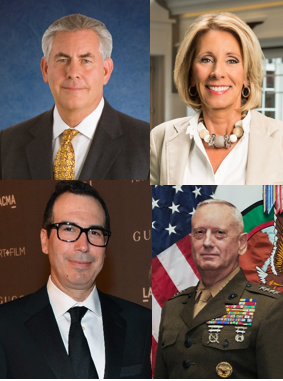The Next Shelf of the Cabinet

December 29, 2016
With Donald Trump’s inauguration growing near, the president-elect has been selecting and announcing the cabinet members that he would like to appoint as president. The tradition of the cabinet is important and long-standing, as George Washington appointed the first cabinet during his presidency. The first cabinet included five offices: the secretaries of state, war, and the treasury, along with the Postmaster General and the Attorney General. Since 1789, the Cabinet of the United States has grown, and now contains the heads of 15 executive departments.
The president’s cabinet has proven to be extremely important to the country because its members can advise the president in-depth on matters that he may not fully understand. Mr. Trump specifically stated during his campaign that he would rely heavily on his cabinet to help him in areas in which he lacks government experience. Therefore, this presidential cabinet will be especially significant in shaping the government’s actions over the next four years.
Mr. Trump’s pick for Secretary of State, one of the most important cabinet offices, is Rex Tillerson. Tillerson is the CEO of Exxon Mobil, and his diplomatic experience comes from his international business dealings. Proponents of this decision praise Mr. Trump’s unexpected choice of a Secretary of State outside of the government. However, this appointment has generated controversy because of Tillerson’s close relationship with the Russian government, which gave him an Order of Freedom Award in 2013.
Another prominent office in the United States Cabinet is the Secretary of Defense. To this position, Mr. Trump has planned to appoint General James Mattis, a retired military officer. General Mattis is a popular choice because of his military background and plans to increase cultural sensitivity training in the armed forces. However, General Mattis’ appointment will face significant opposition since legislation has existed for 65 years that prevents “military men” from serving as the Secretary of Defense.
The office of Secretary of the Treasury, Trump has announced, will be filled by Steven Mnuchin, a former partner at Goldman Sachs. Mnuchin’s job will be an important one because Mr. Trump made so many campaign promises regarding balancing the federal budget and lowering taxes. Unlike the president-elect, Mnuchin’s economic views are not incredibly clear. The expected Secretary of the Treasury is in favor of lowered taxes and fewer regulations on business, but aside from these traditional Republican ideas, it is unclear which policies he will promote.
An additional cabinet position is the Secretary of Education. For this job, Trump has selected Betsy DeVos, the chair of the Michigan Republican Party. DeVos is a billionaire philanthropist and an advocate for school-choice, meaning that she wants to allot money for private and charter schools rather than furthering public education. The school-choice position is highly controversial, since some believe that reducing support to public education will lead to worse educational options for children in the school system.
These are only a few of the cabinet choices that Donald Trump has been announcing over the past month. Mr. Trump’s cabinet appointments are viewed favorably by many, but are also facing significant opposition. The cabinet is in no way definite at this point, since the US Senate must confirm most of these presidential appointments. Still, it is important to have a knowledge of the different cabinet members since, once it is officially formed, the cabinet will have a significant influence on the legislation passed over the next four years.

